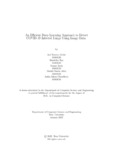| dc.contributor.advisor | Alam, Md. Ashraful | |
| dc.contributor.advisor | Reza, Md. Tanzim | |
| dc.contributor.author | Kabir, Asif Rezwan | |
| dc.contributor.author | Roy, Shutirtha | |
| dc.contributor.author | Zerin, Nusrat | |
| dc.contributor.author | Afrin, Sheikh Sharia | |
| dc.contributor.author | Choudhury, Anika Jahan | |
| dc.date.accessioned | 2022-06-01T05:19:10Z | |
| dc.date.available | 2022-06-01T05:19:10Z | |
| dc.date.copyright | 2022 | |
| dc.date.issued | 2022-01 | |
| dc.identifier.other | ID 18301230 | |
| dc.identifier.other | ID 18301028 | |
| dc.identifier.other | ID 18101533 | |
| dc.identifier.other | ID 18101528 | |
| dc.identifier.other | ID 18301016 | |
| dc.identifier.uri | http://hdl.handle.net/10361/16785 | |
| dc.description | This thesis is submitted in partial fulfillment of the requirements for the degree of Bachelor of Science in Computer Science and Engineering, 2022. | en_US |
| dc.description | Cataloged from PDF version of thesis. | |
| dc.description | Includes bibliographical references (pages 34-35). | |
| dc.description.abstract | The beginning of 2020 will always be a dreadful chapter in human history. Even
with all the recent advancements in the medical sector, the COVID-19 virus proved
to be a major challenge for doctors all over the world. The virus affected different
people in different ways. One of its deadliest symptoms can be observed in our
lungs. COVID-19 can cause various complications in the lungs such as pneumonia,
acute respiratory distress syndrome (ARDS), sepsis, etc. This pandemic, being
highly contagious, can spread and affect a large number of the population in a very
short period. This results in many patients not receiving proper treatment at the
appropriate time. Our proposed CNN model will be able to automate the entire
detection and classification process. It will be trained using large amounts of Xray
images of lungs, which will provide it with the necessary feature knowledge to
distinguish between an infected lung and a healthy one. | en_US |
| dc.description.statementofresponsibility | Asif Rezwan Kabir | |
| dc.description.statementofresponsibility | Shutirtha Roy | |
| dc.description.statementofresponsibility | Nusrat Zerin | |
| dc.description.statementofresponsibility | Sheikh Sharia Afrin | |
| dc.description.statementofresponsibility | Anika Jahan Choudhury | |
| dc.format.extent | 35 pages | |
| dc.language.iso | en | en_US |
| dc.publisher | Brac University | en_US |
| dc.rights | Brac University theses are protected by copyright. They may be viewed from this source for any purpose, but reproduction or distribution in any format is prohibited without written permission. | |
| dc.subject | Covid-19 | en_US |
| dc.subject | CNN | en_US |
| dc.subject | Supervised learning | en_US |
| dc.subject | X-ray image | en_US |
| dc.subject | Tensorflow | en_US |
| dc.subject.lcsh | Neural networks (Computer science) | |
| dc.title | An efficient deep learning approach to detect COVID-19 infected lungs using image data | en_US |
| dc.type | Thesis | en_US |
| dc.contributor.department | Department of Computer Science and Engineering, Brac University | |
| dc.description.degree | B. Computer Science | |

